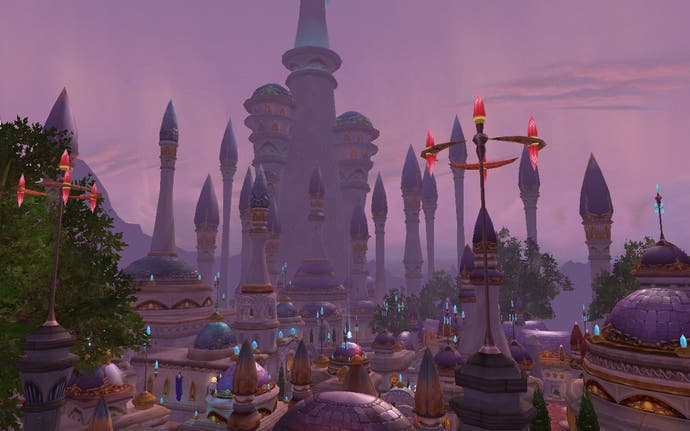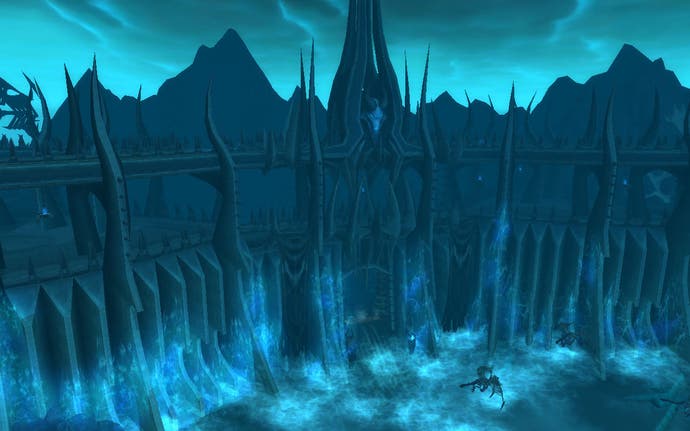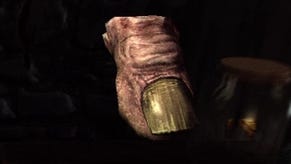World of Warcraft: Wrath of the Lich King
Beta Report Part 3: Exploring Northrend.
Between Grizzly Hills and Sholazar is Crystalsong Forest, Northrend's smallest and prettiest zone. Over this violet-tinged, petrified forest of glass trees is where you'll find the flying capital city, Dalaran. This society of magicians has transplanted itself to the skies above Northrend in order to answer the threat of the Blue Dragonflight.
Mages - who also have the only class trainer in the city - are able to teleport to Dalaran after a quest obtainable at level 71. They can learn a portal at level 74, and then can transport anyone to the city. Other than that, you'll need to be level 74 to learn to use the teleport crystal in Crystalsong Forest to get there, or 78 to learn how to use flying mounts in Northrend's cold climate, and fly there direct.
It's a bold decision, restricting access to the new capital city until so late in the expansion's levelling curve, and burying it so far from the entry points to the continent. It might be frustrating for many players, although it neatly coincides with Wrath of the Lich King's division into two distinct "acts", the first of which culminates with the events surrounding the Wrath Gate in Dragonblight. Blizzard has clearly sunk a lot more effort into thematic, geographical and narrative coherence this time around - while at the same time, not impeding players' freedom to explore (expanding it, in fact).
Dalaran is a very charismatic and charming city, much more so than The Burning Crusade's Shattrath. It's quite compact; the main influences are Silvermoon's beauty, Stormwind's homely alleyways and Undercity's efficient radial design. Instead of the baffling division between the Aldor and Scryer factions in The Burning Crusade, we simply get Horde and Alliance districts, each furnished with a huge inn and a full suite of battlemasters and portals to battlegrounds and capital cities. There's also the Underbelly, a shadier underground town located in the sewers, where you'll find another bank and inn as well as the city's new Arena; and The Violet Hold, a high-end prison dungeon, hopefully more interesting than Stormwind's Stockade.

You can't use flying mounts in Dalaran. As with the entirety of the expansion up to level 78, Blizzard wants to keep players' feet firmly on the ground, creating a sense of bustle and exploration. Some will complain, but it's one of the smartest decisions in the expansion, necessary to pull players off the deeply-ingrained path of least resistance and bring some dynamism and sense of life back to the world.
Beyond Crystalsong, three zones remain. And as gorgeous in their detail as the opening trio of Howling Fjord, Borean Tundra and Dragonblight are, it's in these final three that Blizzard unleashes the raw spectacle of which its world-beating environment artists are capable.
Zul'Drak, joined to Grizzly Hills by the Drak'Tharon Keep dungeon, is a vast Ice Troll civilisation: essentially, a zone-sized city, building in one giant ziggurat toward a second dungeon, Gundrak. Its scale and ruined grandeur, and the linear struggle to climb through its stages toward the foreboding final plateau, give it a sense of drama few MMORPG zones can boast, even in WOW.

The Storm Peaks, meanwhile - a craggy mountain range on the roof of the world - is the most vertical zone Blizzard has made to date. Flying mounts will be essential to fully explore its plunging valleys, soaring ridges and monumental, classical Titan architecture. This is where the majority of the Titan storytelling is done, in the Ulduar instances and the huge, mysterious machines - the "engine of the world" - buried inside the rock.
And then there's Icecrown. This is the location of the Lich King's seat of power, Icecrown Citadel, which we know will not be included in the expansion itself but in a future free update. Once again, like Zul'Drak, this is not so much a zone as a path, a curving glacier bed punctuated with immense fortress walls guarded by bosses. It's so inhospitable that the main Horde and Alliance towns are, in fact, giant airships that restlessly prowl the skies over the action; only the Argent Dawn faction is brave enough to attempt a foothold in the far eastern corner of the zone.

If you ever doubted Blizzard's commitment to involving all players in a single narrative thread, a single titanic struggle to best the Scourge, Icecrown will silence your doubts. It's an entire zone given over to one thing: climax. It's so outrageously, almost comically evil that its soundtrack actually features reverberating organ chords. There's no doubt that it will deliver a mighty payoff, even for solo adventurers, although there is a price; unlike every other zone in Wrath of the Lich King, it's not really a place you want to hang out in.
There's one zone we haven't discussed, Wintergrasp. Since it's specific to player-versus-player siege warfare rather than exploration, we'll return to it at a later date. As for the rest of Northrend, the conclusion is very simple: it's more epic and far more beautiful than classic WOW, more exciting and far more coherent than Outland. The only competition Blizzard's artists have as world-builders is themselves, and they're going to have to go a long, long way to top Northrend.
World of Warcraft: Wrath of the Lich King is due out for PC and Mac on 13th November.








